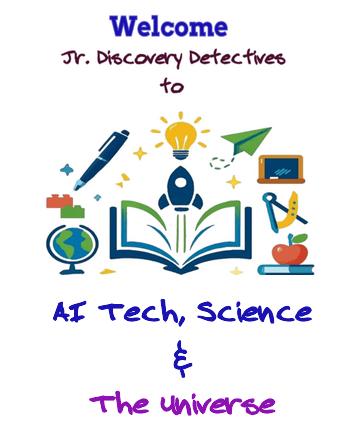
🤖 Fun Tech Fact for Kids:
Did you know that AI can learn to recognize animals, play games, and even create art — all by studying patterns just like your brain does when you learn something new? 🧠 Every time an AI gets “smarter,” it’s kind of like it’s going to digital school! 🎓✨
Introduction
Hey there, Jr. Discovery Detectives! 🌟 Have you ever wondered how your favorite game characters seem to “think,” how your tablet knows your voice, or how robots can recognize faces? The secret behind all of this magic is something called Artificial Intelligence, or AI for short.
AI might sound like something from a sci-fi movie, but it’s real — and it’s changing the world around us in ways you can actually see, touch, and explore. So grab your detective notebooks, because today, we’re diving deep into the science, the fun, and the mystery of how computers can think, learn, and create almost like humans!
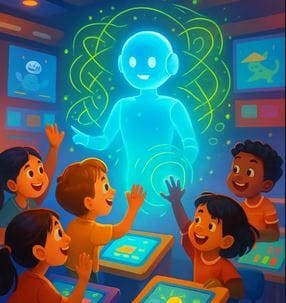
🕵️♀️ What Is Artificial Intelligence, Really?
Imagine if your computer could learn from experience the same way you do. That’s the big idea behind Artificial Intelligence. It’s a special type of computer technology that lets machines analyze information, recognize patterns, and make decisions — often without being told exactly what to do every single time.
Instead of just following simple instructions like “add these numbers,” AI systems can figure out the best way to solve problems on their own by studying lots and lots of examples.
Here’s a fun way to think about it:
Regular computer: A calculator that does what you tell it to.
AI: A detective that studies clues, learns from past cases, and starts solving mysteries on its own! 🕵️♂️
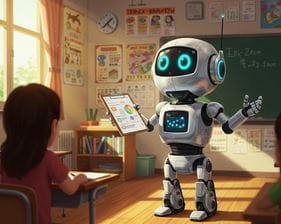
🤔 How Does AI Learn?
Let’s imagine you’re learning to play basketball. At first, you might miss a few shots. But after practicing, your brain starts to notice what works — how hard to throw, where to aim, and when to jump. AI learns in a similar way, except instead of a brain, it uses something called a neural network — a system that mimics how our own brains connect and learn.
Here’s how AI “practice” works in simple steps:
Data Collection 🧩 – The AI gathers examples, like thousands of pictures of cats or different sounds of music.
Training 💪 – It looks at all those examples and starts noticing patterns — maybe that cats usually have whiskers and pointy ears!
Testing 🧠 – After learning, the AI tries to identify new things it’s never seen before.
Improvement 🔄 – If it gets something wrong, it goes back, reviews what it learned, and gets better over time.
This type of learning is called machine learning, one of the main “superpowers” of AI.
🎨 The Many Faces of AI
AI isn’t just one thing — it’s a whole team of technologies that work together in amazing ways. Let’s meet a few members of the AI family!
1. Machine Learning (ML)
This is the “student” part of AI. It helps machines learn from experience. Every time you watch a new show on a streaming app and it recommends another you might like — that’s ML at work!
2. Natural Language Processing (NLP)
This helps computers understand and talk in human language. When you ask your smart speaker, “What’s the weather today?” and it answers — you’re hearing NLP in action!
3. Computer Vision 👀
AI can also “see” using cameras and sensors. It helps robots recognize objects, doctors spot diseases on X-rays, and even cars drive themselves safely!
4. Robotics 🤖
Robots use AI to move, grab, and interact with the world. From underwater explorers to Mars rovers — robots are the hands and feet of artificial intelligence.
5. Generative AI 🎨
This is one of the most creative forms of AI! It can make art, music, stories, and even new inventions by learning from human creativity. Tools like ChatGPT and DALL·E use generative AI to help people bring their ideas to life.
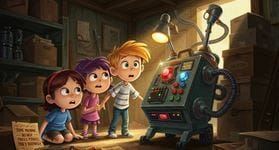
🌍 Where We See AI in Everyday Life
AI might sound super high-tech, but it’s actually all around us! Here are a few everyday places you might already be using it:
Voice Assistants (like Siri, Alexa, or Google Assistant) help answer questions and play your favorite songs.
Video Games use AI for smart opponents that can change strategies as you play.
Streaming Platforms like Netflix or YouTube recommend shows and videos you might love based on what you’ve watched before.
Smart Devices like thermostats or lights that adjust automatically use AI to learn your habits.
Healthcare uses AI to help doctors read scans faster and predict illnesses earlier.
Education Tools can adapt lessons to your learning style, helping you understand tricky topics more easily.
Pretty cool, right? AI isn’t just for scientists — it’s part of everyday fun, safety, and creativity!
🧩 The Secret Ingredient: Data
If AI is the detective, then data is the evidence. Data is made up of information — like pictures, words, numbers, or sounds — that AI studies to learn patterns. The more data it has, the smarter it becomes.
But data also has to be clean, fair, and safe. That means making sure AI doesn’t accidentally learn from incorrect, biased, or harmful examples. Just like detectives need honest clues, AI needs accurate data to make fair decisions.
Families and teachers can help kids understand this too — it’s important to think critically about information online and remember that not everything on the internet is true. AI is only as good as the data it’s given!
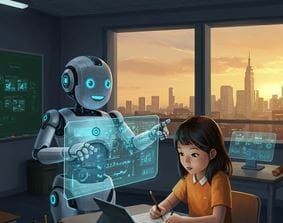
⚙️ How AI Helps People
AI isn’t here to replace humans — it’s here to help humans do things faster, better, and safer. Let’s look at some real-world examples that show how powerful and positive AI can be:
🏥 In Medicine
AI helps doctors discover diseases early, create new medicines faster, and even guide robots in surgery!
🚗 In Transportation
Self-driving cars use AI to detect traffic lights, avoid obstacles, and reduce accidents.
🌾 In Farming
Farmers use AI-powered drones to check crops, save water, and grow food more efficiently.
🦸♀️ In Safety and Rescue
AI helps find missing people, predict natural disasters, and even assist firefighters with smart robots.
🏫 In Education
Teachers can use AI tools to personalize lessons so every student learns at their own pace.
💡 Fun AI Facts to Amaze Your Friends
The idea of AI started way back in the 1950s — long before smartphones even existed!
The first chatbot, ELIZA, was created in 1966 to simulate a conversation with a person.
AI can now help create music, poetry, and paintings that feel totally human-made.
Some AI programs can even translate animal sounds into data to help scientists understand communication in dolphins or elephants! 🐬🐘
AI is used in space exploration, helping analyze distant planets and send data back to Earth faster.

🧠 Can AI Think Like a Human?
That’s one of the biggest questions scientists are still exploring! AI can learn patterns and even make creative choices, but it doesn’t feel emotions or have self-awareness like humans do.
Think of it this way: AI can play chess like a champion, but it doesn’t know it’s winning. It doesn’t feel proud or excited. It just follows the rules and uses logic to make the best move.
Humans still lead the way when it comes to imagination, empathy, and emotional understanding — things that make us wonderfully unique! 💫
🌱 The Ethics of AI
With great power comes great responsibility!
AI can do amazing things, but it’s important that scientists and developers use it safely and fairly.
Here are a few big ideas to think about:
Privacy: Protecting personal information is super important. AI shouldn’t use your data without permission.
Fairness: AI must be trained on diverse examples to avoid being biased.
Transparency: People should understand how AI makes decisions.
Safety: AI should be tested carefully to make sure it doesn’t cause harm.
These principles help build ethical AI — technology that benefits everyone, not just a few.
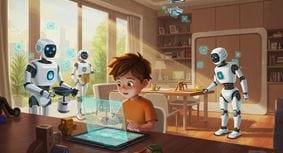
🎉 Here are your 2 bonus mini activities — one for Puzzle Games and one for Python Coding
🧩 Mini Detective Challenge: AI Logic Puzzle
Mission: Train your brain to think like an AI!
AI learns to solve problems by looking for patterns and rules. You can practice the same skill with this logic puzzle.
🔍 The Puzzle:
Three robots are sorting shapes on a conveyor belt:
Robo-1 sorts red shapes.
Robo-2 sorts blue shapes.
Robo-3 sorts yellow shapes.
Now a new set of shapes comes through:
🟥 🔵 🟨 🔵 🟥 🟨 🟨 🔵
Can you figure out which robot will handle the most shapes and which will handle the fewest?
Then, try to explain why!
🧠 Detective Tip:
To think like an AI, look for patterns and count carefully. Write your answers in a notebook and see if your friends or family agree with your reasoning!
💻 Kids Can Code Too — Learning Logic Through Python
Coding might sound like something only adults or computer scientists do, but guess what? Kids can code, too! 🌈
One of the best beginner-friendly programming languages is called Python 🐍 — not named after the snake, but after a comedy show called Monty Python! Python is used all around the world by professional developers, scientists, and even AI researchers.
Here’s why Python is awesome for kids:
It’s easy to read, almost like writing simple sentences in English.
It helps you see results fast, so learning feels exciting.
You can make games, draw graphics, or even train mini AIs once you learn the basics!
When you write code in Python, you’re teaching the computer how to think logically. For example:
PYTHON CODE EXAMPLE:
if it’s raining:
take an umbrella
else:
go outside and play
That’s how machines follow logic — by using “if this, then that” thinking!
Starting with Python is like learning a new language for communicating with computers. And once you understand that, you can build apps, games, or even your very own smart assistant one day. 🌟
💻 Mini Coding Challenge: Teach the Computer to Decide!
Mission: Use logic to help your “virtual robot” make a smart choice!
🧠 Try This Simple Python Example:
weather = input("Is it sunny or rainy today? ")
if weather == "sunny":
print("Let's go outside and play! ☀️")
elif weather == "rainy":
print("Better grab an umbrella! ☔")
else:
print("Hmm, I’m not sure what to do. Let's check the forecast! 🌦️")
🔍 Your Task:
Copy this code into a free online coding tool (like Replit.com or Trinket.io).
Run it and type different weather words — see how the program responds!
Then customize it — change the weather options, add new conditions (like “snowy” or “windy”), or make it tell a funny joke.
🎯 Detective Tip:
Each if, elif, and else statement is a decision point — just like how AI decides what to do next when it sees new data.
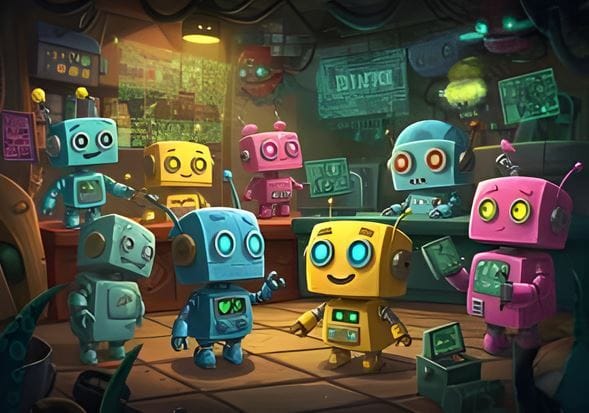
🌐 AI and the Future You’ll Help Shape
As you grow up, AI will keep evolving — and you might be one of the people designing its future! The world will need creative thinkers, ethical leaders, and innovative problem-solvers who understand both how AI works and how to use it wisely.
In the coming years, AI could help:
Clean up oceans and protect wildlife 🐢
Create better schools for every type of learner 🎓
Design smarter cities that use clean energy 🌆
Help scientists solve the biggest mysteries of space 🌌
AI’s future is a team effort — between humans and machines working together. And it starts with learning, curiosity, and a sense of adventure.
🕹️ Jr. Detective Challenge: Your Mini AI Mission
Here’s your challenge this month:
Write down three ways you already use AI every day — you might be surprised!
Think of one problem in your community that AI could help solve.
Share your ideas with your family or teacher. Discuss how technology can make life better for everyone.
That’s how every great innovator begins — by connecting imagination with purpose.
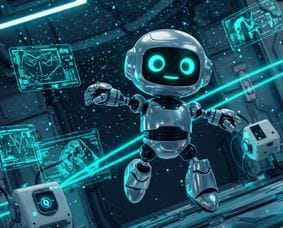
🚀 Final Thoughts: Curiosity Is Your Superpower
Artificial Intelligence isn’t magic — it’s the result of human creativity and discovery. It’s proof that when people dream big, they can teach machines to dream along with them (in their own digital way!).
As Jr. Discovery Detectives, your job is to keep asking questions, exploring ideas, and thinking ethically about how technology shapes our world. AI is one of the greatest inventions of our time — but the most powerful intelligence of all will always be human curiosity.
So keep learning, keep experimenting, and who knows — maybe one day, the next big AI breakthrough will have your name on it. 🌟
🌟 Subscribe Now for FREE and Become a Jr. Discovery Detective!
✨ Every issue unlocks a new world of wonder.
🧠 Every story helps you learn something amazing.
🚀 Every mission takes you one step closer to the stars.
Join CyberLens Innovations as we launch the next generation of explorers — kids who love learning, families who love discovery, and a community that believes curiosity can change the world.

